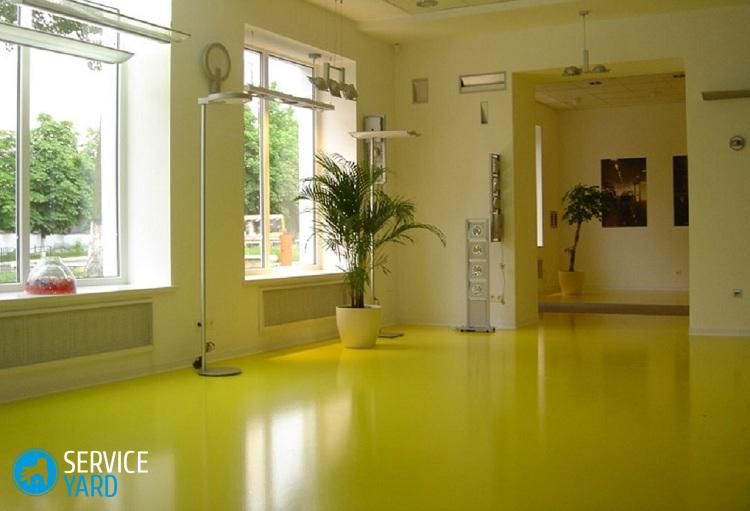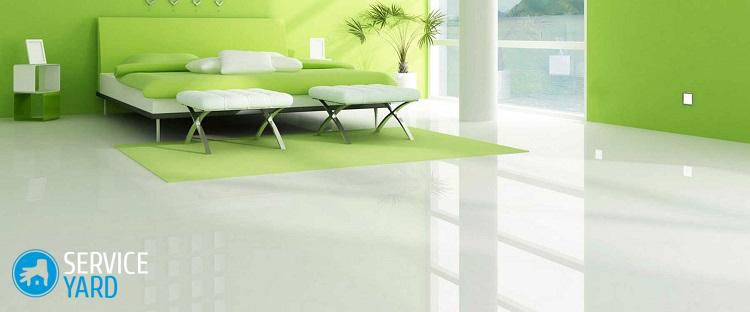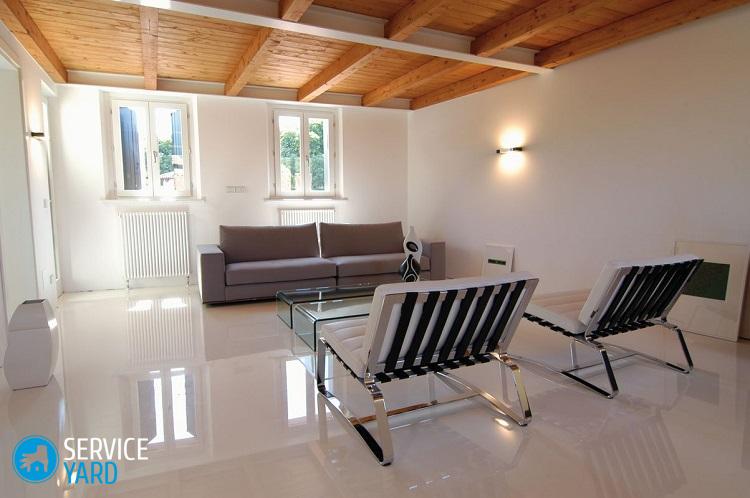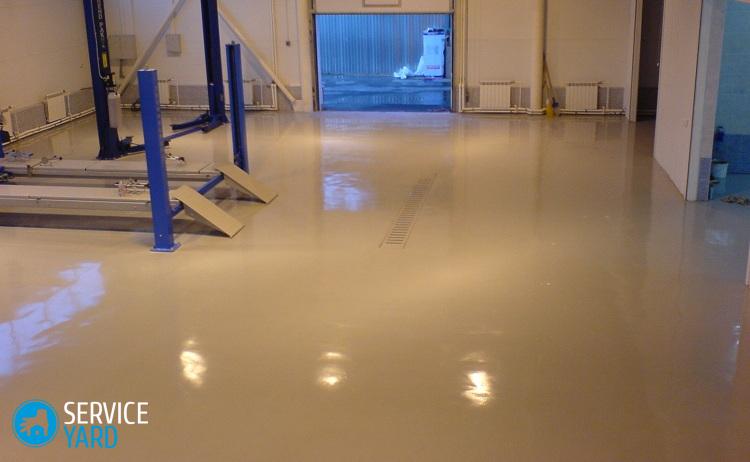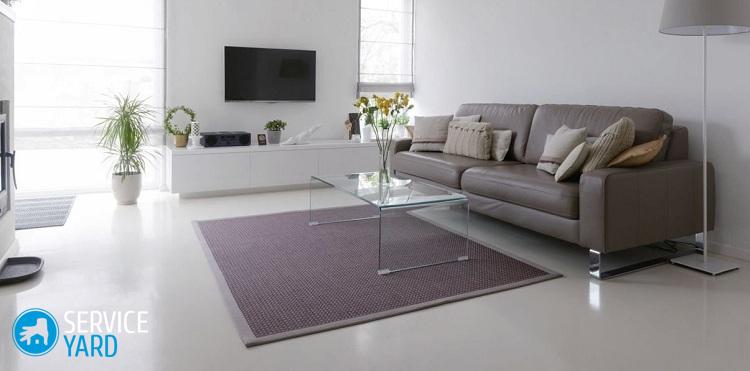Epoxy flooring

Self-leveling floors are one of the most modern, beautiful and durable flooring. And it is not at all surprising that they are becoming increasingly popular, more often found in private houses and city apartments, and not just in offices. At the same time, there are several varieties of this flooring - polyurethane, cement-acrylic, and also epoxy floors, which are distinguished by their long term of use and special durability. Their features and consider in this article.
to contents ↑The composition of the base
Epoxy resin is used for the manufacture and strengthening of various products from varnishes, plastics, textolite, adhesives and other materials. Modern capabilities and technologies allow using it to create floor coverings.
Epoxy bulk coating is a composition that is created from two components - the epoxy itself, as well as a hardener for it. In addition, the composition includes coloring pigments that give the floor the desired color, special additives and fillers that provide additional wear resistance and strength, as well as uniform distribution of the substance on the surface of the screed or subfloor.
to contents ↑Properties and Application
Bulk epoxy floors are particularly durable and smooth, they are resistant to abrasion and for a long time do not lose their beautiful appearance. However, such a coating may not necessarily be glossy - it is possible to create matte or semi-matt.
They are ecologically completely safe, and also have excellent fire safety indicators.
Important! Requirements for epoxy bulk floors are fixed in GOST-R 50766-95. This regulatory document reports that this type of coating, due to its characteristics, can be used in printing houses, in the food industry. in the production of medicines and in many other industries.
Especially often, epoxy resins are used for the manufacture of floor coverings in educational institutions, clubs and cafes, and residential premises. They can also be used not only indoors, but also in open areas due to their unique durability.
to contents ↑Types of epoxy floors
Epoxy floors are divided into several types. Separation, in turn, depends on the specific operating conditions. Let's take a closer look at them:
- Thin layer. The thickness of such a coating is only 1 mm. However, at the same time, the material has exceptional strength and copes well with everyday mechanical and chemical loads in the apartment. This coating is laid in one layer.
- Thick layer. This type may consist of several layers, each of which will have a thickness of 1 mm. The multilayer structure makes it possible to increase strength indicators. A wonderful view of the flooring is suitable for a private house or apartment, as well as for an office building with low traffic.
- Epoxy industrial. Ideal for use in production plants, as it can easily withstand critical loads - both chemical and mechanical. It may have a different color and texture.
- Quartz. In the composition of their lower layer there is quartz sand, which provides the most reliable adhesion of the base and the finish layer. Such a coating is not afraid of any kind of load, it is particularly reliable and easily decorated.
Advantages and benefits of epoxy floors
Understanding why epoxy bulk floors are very popular is easy. It is enough to get acquainted with their main advantages. Of the main advantages of this type of flooring, the following can be noted:
- Such floors are easy to wash and clean - it is much easier to remove dirt from them than from parquet and laminate.
- The material does not react in any way to temperature fluctuations - its quality and performance are not reduced, which makes it possible to use the coating in saunas or unheated rooms.
- During the installation of the bulk floor, gaps and joints do not appear, which means that dirt does not accumulate and pathogens do not arise.
- Absolute absence of seams - no need to use sills.
- Wear resistance and high strength indicators - epoxy resins can serve for decades without loss of external decorative properties.
Important! Chips and scratches during operation can sometimes appear on epoxy resins, but they can be easily removed with a brush and epoxy.
- The material is inert to chemicals - such a floor is not afraid of either alkalis or acids.
- The epoxy coating is completely odorless, with the exception of the setting time immediately after pouring.
- Excellent waterproofing performance is also an advantage of using such a coating. The material can be mounted without waterproofing.
However, even such a seemingly ideal coating as an epoxy floor is not without some drawbacks, among which the following can be highlighted:
- The high cost of materials, as well as tools that are needed for installation of the coating.
- Damage to the coating can occur due to the fall of a heavy object. Scratches and chips must be repaired immediately, as they are very striking.
- If it becomes necessary to dismantle it will be very difficult.
Requirements for the premises
Despite the universality of the coating, the creation of a bulk floor can only be carried out in special conditions. So, there are restrictions on the use of this type of coating:
- In the room where installation work will be done to create an epoxy floor, a certain temperature regime must be observed - from 5 to 25 degrees. In addition, such a temperature should have not only indoor air, but also the rough floor itself. Work should be carried out by a composition that also has a certain temperature - from 15 to 20 degrees.
- The humidity in the room cannot exceed 80%, and the humidity of the base should be no more than 4%. The last indicator can be checked using a special device or an ordinary plastic film. The material is fixed to the base and remains so for a day, after which it is removed. Humidity is assessed by the presence or absence of condensate - if water is present on the surface of the film, then the base can be considered too wet and the floor cannot be filled.
Important! Store the epoxy mixture used for the manufacture of bulk floors should be at a temperature of -30 to +30 degrees.
- It is also important that the subfloor is even and clean before pouring epoxy. It should not have debris, dust, grease stains. Roughnesses on the basis are also certainly corrected - cracks are closed and polished.
to contents ↑Important! A self-leveling mixture will help level the base of the floor. It is possible to fill the epoxy composition for the floor only after it has completely hardened.
Tools and materials
To make the room an epoxy bulk floor, you will need certain tools and materials.You should not save on them, since the quality of the final work will depend on this.
Of the tools that are required to work, we can distinguish the following:
- Needle roller.
- Construction mixer or drill with a special nozzle.
- Brush and vacuum cleaner.
- Kraskozhody.
- Raklya and spatula.
- Building level.
- Container for mixing components.
- Gloves, respirator, protective clothing.
The materials for filling the epoxy floor will require the following:
- Quartz peeled sand.
- Primer mixture.
- Polyethylene film.
- Clear polyurethane varnish.
- Epoxy based putty.
- The bicomponent mixture itself.
to contents ↑Important! Soil consumption for a rough surface depends directly on the brand of concrete used - the larger its digital designation, the lower the consumption. For example, for M200 brand concrete, the material consumption will be 300 g / m3, and for M350 concrete - only 150 g / m3. The need to purchase certain materials will also depend on the type of coating chosen.
Leading manufacturers
The compositions of epoxies for creating bulk floors may vary slightly, depending on the company that produces them and the production technology. However, the main components remain unchanged. The decorative properties of the final coating will depend on the type of epoxy composition. Let’s look at several popular manufacturers of epoxy bulk flooring mixes.
Elacor ED (TheoChem)
Color composition, which after hardening is characterized by high strength characteristics:
- Its composition is the color base A (epoxy), as well as hardener B.
- It does not have an unpleasant odor when applied and is characterized by excellent high decorative characteristics.
- It has excellent waterproofing and is not afraid of ultraviolet rays.
- Consumption for the finish layer is 1.7-1.8 kg / m 2 with a thickness of 1 mm, for the underlying layer - about 300-400 g / m 2.
Napox
Material from domestic manufacturer:
- It features high strength characteristics, as well as excellent wear resistance.
- He is not afraid of chemical or mechanical stress.
- It has good adhesion to any surface.
- It can be used on concrete substrates, steel coating, cement screed, wooden base.
- Consumption for the finish layer of this composition is approximately 300-400 g / m2. Layer thickness 1.5-5 mm.
Taping (TNP Group)
The company produces various mixes for bulk floors:
- They can be used both for ordinary bulk floors and for creating 3D coatings.
- The material is decorative and has excellent strength characteristics.
- The consumption of the final layer of the mixture is 759-900 g / m2. Layer thickness 1 mm.
Primer of the base and pouring of the underlying layer:
- At the stage of surface preparation, the elimination of cracks and all other existing damage. To do this, use a cement-sand mortar.
- After preparing the base, a surface primer is performed. The mixture is prepared in a container with component “A”.
Important! Some formulations include the addition of sand during the preparation phase of the mixture.
- After kneading, the composition is sent to ripen for 2-3 m.
- After the mixture ripens, it is filled from the far corner of the room towards the exit.
- After the material is poured, its distribution is carried out with the help of an iron trowel by the “shear” method. So, the underlying layer should fill all the pores and cracks on the surface.
Epoxy Flooring Technology
The technology for pouring epoxy floors is quite simple - it is only important to be careful when working with the material so as not to ruin the final work:
- First, prepare the foundation. Clean the subfloor from debris, remove any defects from the surface. If necessary, pour the cement screed, and then wait a while until it is completely dry.
- Measure the moisture content of the substrate. To do this, you can use a special device or method with polyethylene, which we described above.
Important! Wet concrete must be completely dried before pouring epoxide. Otherwise, the technology of applying the epoxy composition will be violated and the coating will turn out to be of poor quality.
- Grind the base with a grinder. In hard-to-reach places, treat the surface with a manual machine.
- Remove dust after grinding with a vacuum cleaner.
- Putty all cracks, bumps and bumps.
- Prime the entire rough surface of the floor. Drying time - approximately 12-15 hours.
- Mix the components of the epoxy compound - A and B, using a construction mixer.
- Pour the finished epoxy mixture on the floor and level it with a squeegee. You can move on the applied material in kraskostoy - a special studded shoe.
- To eliminate the air that has got into the mixture, treat the surface of the material with a special needle roller. This procedure should be carried out no later than half an hour after applying the composition to the base.
So, the epoxy floor is ready. You just have to dry it.
to contents ↑Helpful hints:
- When drying, it will be possible to carefully move around it after 24 hours. It will completely harden in 5 days.
- If necessary, such floors can be poured in 2-3 layers. In this case, the base layer is applied to a primed and completely dried coating. After the base layer has dried, a topcoat is applied. When, in turn, it dries, the surface can additionally be varnished with polyurethane varnish. It will give the coating more strength and make it glossy.
- The epoxide begins to polymerize quickly enough. That is why it is necessary to work with it at a fairly high speed. It should not stay in the tank for more than 10 minutes. However, it must be applied very carefully to the base. After applying the material and until it hardens, you will have to make sure that no debris and dust get on it - the windows in the room must be closed.
to contents ↑Important! Epoxy mixtures of different colors during the pouring process can be mixed with each other, as well as zoned. This produces very interesting color schemes.
Stock footage
Now you know how to make epoxy floors with your own hands. As you can see, the technology for creating them is quite simple, the main thing is to follow all the instructions and recommendations steadily.
- How to choose a vacuum cleaner taking into account the characteristics of the house and coatings?
- What to look for when choosing a water delivery
- How to quickly create comfort at home - tips for housewives
- How to choose the perfect TV - useful tips
- What to look for when choosing blinds
- What should be running shoes?
- What useful things can you buy in a hardware store
- Iphone 11 pro max review
- Than iPhone is better than Android smartphones





